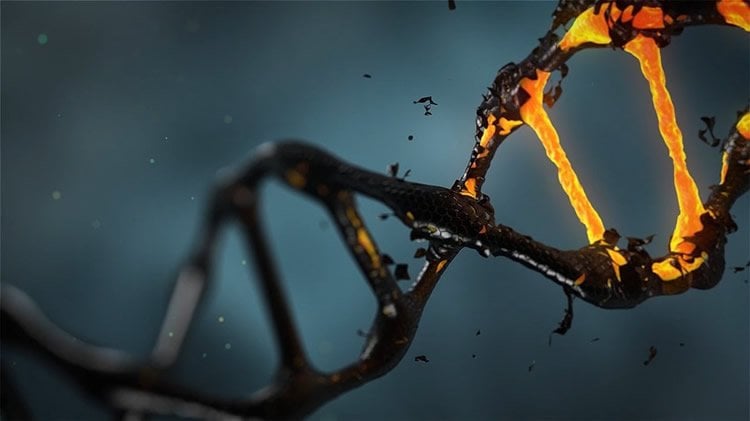Summary: A new study reports researchers have developed a new gene editing approach that may provide a new treatment avenue for Huntington’s disease.
Source: Frontiers.
A new variant of the gene-editing CRISPR/Cas9 system is safer and more specific than versions previously used in early research towards a treatment for Huntington’s disease, shows research published today in Frontiers in Neuroscience.
The idea of editing genes to cure disease is becoming closer to a reality every day. For genetic diseases such as Huntington’s disease — an incurable neurodegenerative disease caused by a well-recognized defective gene — simply cutting out the disease-causing DNA sequence seems like it could be the ultimate cure. But before anyone goes anywhere near snipping up a patient’s DNA, researchers are taking every step to make sure that they have the safest and most effective methods.
“In our study we further improve the CRISPR/Cas9 approach by using a nickase version of Cas9,” says Dr. Marta Olejniczak, group leader of the study and an associate professor at the Institute of Bioorganic Chemistry in Poland. “Because Cas9 nickases are known to be safe and specific, our approach provides an attractive treatment tool for Huntington’s disease.”
Huntington’s disease is caused by the abnormal repetition of a specific DNA sequence at the tail end of the huntingtin gene. This defective mutant gene causes production of a toxic protein that progressively accumulates and damages the patient’s neurons. The disease usually begins in a patient’s 30s or 40s and, in the decades after disease onset, patients gradually lose the ability to move, talk and even think.
There is currently no cure for Huntington’s disease. But researchers have tried many methods to silence the defective gene. This includes interrupting production of the toxic protein through DNA- and RNA-based approaches. Most recently, researchers have also begun work with one of the most promising gene-editing tools to date — the CRISPR/Cas9 system, which is far easier, faster and more specific than past tools. But it is still the early days of medical applications of CRISPR/Cas 9, which was only discovered in 2012.

To make sure that this technique is as safe and effective as possible, Olejniczak’s group has been testing out a new variant of the Cas9 protein component in cellular models from a Huntington’s patient. This version of Cas9 was recently designed to act as a nickase — an enzyme that cuts just one DNA strand instead of two, which increases the precision with which Cas9 can edit specific sequences of DNA.
“We demonstrated that excision of the repeat tract with the use of a Cas9 nickase pair resulted in inactivation of the huntingtin gene and abrogation of toxic protein synthesis in cellular models of Huntington’s disease,” says Dr. Olejniczak. “Our strategy is safe and efficient, and no sequence-specific side effects were observed.”
There is much more future work to be done and further improvements are still needed, but this research represents one small step closer to a possible treatment for this devastating genetic disease.
Funding: National Science Center, Leading National Research Center Program 2014-2018 funded the study.
Source: Frontiers
Publisher: Organized by NeuroscienceNews.com.
Image Source: NeuroscienceNews.com image is in the public domain.
Original Research: Open access research in Frontiers in Neuroscience.
doi:10.3389/fnins.2018.00075
[cbtabs][cbtab title=”MLA”]Frontiers “One Step Closer to Treatment for Huntington’s.” NeuroscienceNews. NeuroscienceNews, 26 February 2018.
< https://neurosciencenews.com/crispr-cas9-huntingtons-8558/>.[/cbtab][cbtab title=”APA”]Frontiers (2018, February 26). One Step Closer to Treatment for Huntington’s. NeuroscienceNews. Retrieved February 26, 2018 from https://neurosciencenews.com/crispr-cas9-huntingtons-8558/[/cbtab][cbtab title=”Chicago”]Frontiers “One Step Closer to Treatment for Huntington’s.” https://neurosciencenews.com/crispr-cas9-huntingtons-8558/ (accessed February 26, 2018).[/cbtab][/cbtabs]
Abstract
Precise Excision of the CAG Tract from the Huntingtin Gene by Cas9 Nickases
Huntington’s disease (HD) is a progressive autosomal dominant neurodegenerative disorder caused by the expansion of CAG repeats in the first exon of the huntingtin gene (HTT). The accumulation of polyglutamine-rich huntingtin proteins affects various cellular functions and causes selective degeneration of neurons in the striatum. Therapeutic strategies used to date to silence the expression of mutant HTT include antisense oligonucleotides, RNA interference-based approaches and, recently, genome editing with the CRISPR/Cas9 system. Here, we demonstrate that the CAG repeat tract can be precisely excised from the HTT gene with the use of the paired Cas9 nickase strategy. As a model, we used HD patient-derived fibroblasts with varied numbers of CAG repeats. The repeat excision inactivated the HTT gene and abrogated huntingtin synthesis in a CAG repeat length-independent manner. Because Cas9 nickases are known to be safe and specific, our approach provides an attractive treatment tool for HD that can be extended to other polyQ disorders.






